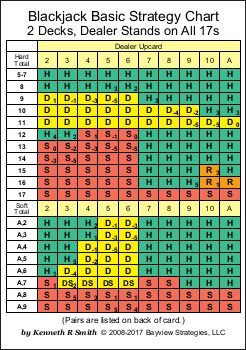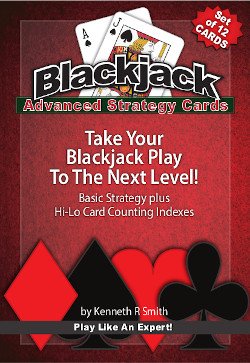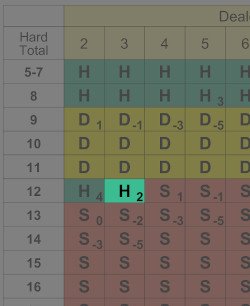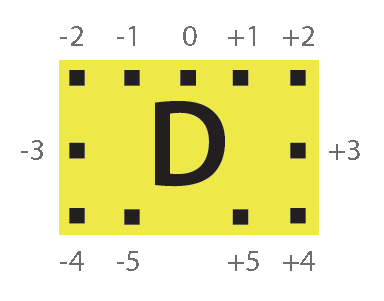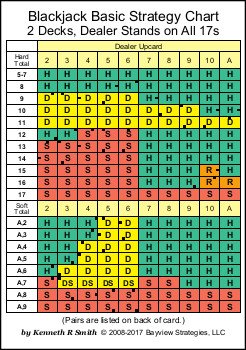Blackjack Advanced Strategy Card Instructions
Getting Started
The advanced cards are based on the same optimal basic strategy information from the basic set. So the first step is to make sure you understand how that works, by looking at the basic strategy card instructions.
After that, click the example image here to zoom in on the advanced card and see the additional information provided in the form of numbers inside some of the decision squares.
Read on to understand what that's about...
The Advanced Strategy requires card counting...
Because the extra information on these cards is all about card counting, you'll need to understand how the popular Hi-Lo or Plus/Minus counting system works.
Honestly, if you're not sure what I'm talking about, you probably aren't ready for this card set.
But nonetheless, here's a quick intro to card counting.
A Super-Short Intro to Card Counting
In blackjack, small cards are bad for the player, while ten-valued cards and aces are beneficial for the player.
Card counting allows us to exploit that by keeping track of the relative number of small cards and large cards that have been used up, and betting more when the remaining shoe is rich in face cards and aces.
The most popular card counting system is known as the Hi-Lo count, and it is really pretty simple.
The Hi-Lo Count
After each fresh shuffle, you start your count off at zero. Each time that you see a small card (2, 3, 4, 5, or 6), you add 1 to your running count.
Each time you see a ten-valued card or an ace dealt, you subtract 1 from your count.
By assigning a positive value to the small cards and a negative value to the large cards, our running count will be a positive number when the remaining undealt cards contain a surplus of favorable large cards. (Because we've seen more small cards than large ones so far.)
However, there is one complication. Having a surplus of five or six extra large cards in the shoe is not all that meaningful when the shoe has just begun, as they are spread out over many undealt decks.
Converting to a True Count
To account for this, we adjust the running count to a "true count" by dividing it by the number of decks remaining in the shoe.
If our count is +5 and we are only one deck into a six-deck shoe, then we divide +5 by 5, the number of unseen decks and get a true count of +1. (That means there is an average of one extra high card per deck remaining in the shoe.)
If our count is +5 and we have seen 4 decks and only 2 decks remain unseen, the same +5 gets divided by 2 instead, and our true count is now +2.5, a more favorable situation.
Bet more when you have the edge
As a good rule of thumb, a player is playing a break-even game when the true count is around +1 or a little higher.
Once the true count reaches +3 or so, a savvy player will have increased his bet size to take advantage of the favorable conditions.
At true counts of +5 or higher, you should be making your largest bets, keeping in mind the risk in proportion to your bankroll.
And when the count is zero, or negative? We want to bet as little as possible in those cases.
OK, that's it for the abbreviated explanation of card counting. If you want to learn more, I heartily recommend the free Blackjack School hosted at a site that I created more than 20 years ago. I'm no longer affiliated with BlackjackInfo.com, but it remains an excellent resource.
If this has been your only exposure to these ideas, it will be well worth your time to pick up a quality book on the subject. Here are a couple that I recommend:
How the Advanced Strategy Cards help
Most of the advantage from card counting comes from simply betting more when the remaining decks are favorable, and as little as possible when the casino has the edge.
But you can also put your knowledge about the undealt cards to use in another way.
When you know that the remaining deck is chock-full of either high card or low cards, you can adjust your playing strategy on some key hands to take advantage of that knowledge.
And that is exactly what Hi-Lo index numbers allow you to do. They allow you to deviate from normal basic strategy in a mathematically accurate way based on the current true count.
The index numbers presented on the advanced strategy cards are carefully calculated for the exact rule variations on the card, to provide accurate advice on when you can safely play your hand differently than normal.
Let's Look at a Specific Example
Let's assume you are dealt the following hand:
Your Cards:


Dealer Upcard:

Correct basic strategy for 12v3 is to hit the hand. However, if we are counting cards and know that the remaining deck has more high cards than usual, it can make sense to stand on this hand instead.
With more high cards remaining in the shoe, our chance of busting our 12 is higher than usual, and the dealer's chance of busting is also increased. Both of these facts mean that hitting 12v3 in this situation has less value than usual.
The question is: How high does the true count need to be make standing a better play than hitting this hand?
That's exactly what the advanced strategy cards provide. Take a look at the image, and you'll see an index number for 12v3 of "2", meaning "+2".
This means that whenever our true count is +2 or higher, we should stand on this hand.
If the true count is less than +2, we'll hit the hand instead.
To recap, for the hands where the index is a Hit/Stand index (more on that in a moment), you should hit the hand when the true count is below the index number, and stand on the hand when the true count is equal to or higher than the index number.
This is not unique to the advanced strategy cards. It's the standard way of using index numbers with the Hi-Lo system.
The Different Kinds of Index Numbers
Index numbers are used for more than just hit or stand decisions.
In fact, there are five groups of index numbers on the cards.
| Hand Type | Index Type | What the Index Means |
|---|---|---|
| Hard 8 - 11 | Double or Hit | Double if the true count is >= the index. Otherwise, hit. |
| Hard 12 - 16 | Stand or Hit | Stand if the true count is >= the index. Otherwise, hit. |
| Soft A2 - A6 | Double or Hit | Double if the true count is >= the index. Otherwise, hit. |
| Soft A7 - A9 | Double or Stand | Double if the true count is >= the index. Otherwise, stand. |
| Pairs 22-AA | Split or Don't Split | Split the pair if the true count is >= the index. Otherwise, play as a normal hand. |
There is one additional index number that is quite helpful, that does not appear on the card. When the true count is +3 or higher and the dealer has an ace up, you should take insurance. (In one-deck games, you can insure at +2 or higher.)
If this seems confusing, don't worry. With just a little practice, it becomes quite obvious what each index number is intended to represent. No other interpretation makes sense in each group.
The "Stealth Mode" Cards
Card counting is legal, but that doesn't mean the casinos like it! Instead of carrying our cards with the index numbers indicated by numbers on the card, you can instead use our stealth mode cards in the casino.
These cards present the same index number information, by using a series of dots in different locations inside the decision squares. Each value from -5 to +5 puts the dot in a different location like a clock face.
Here is an example comparing the numeric version to the stealth version in a section of the card.

An example of numeric indexes

The same example, with dots instead
I actually find that sometimes it is easier to recall index numbers from memory using this visual aid than to just remember the actual index number by itself!
Some Technical Details
For those who ask about the technical details of these index numbers, they were generated using "floored" true counts.
That is, the calculations of a fractional true count were always rounded down, or floored. A true count of +1.6 becomes +1. A true count of -2.1 becomes -3, etc. Flooring is usually considered the most effective method, when choosing between flooring, rounding, or truncating.
If you have ever experimented with creating your own index numbers, you certainly found quite soon that the indexes are interrelated. Making a change in one can cause changes in many others. As a result, these numbers are the result of an extensive iterative process that involved implementing any changes and recalculating all the indexes. This continued until no more changes were occurring.
Wrapping Up
One last point: If you ever are unsure about whether to deviate from basic strategy or not, just play the hand using normal basic strategy.
You can cost yourself more by deviating from basic strategy inaccurately than if you simply always play basic strategy in the first place. It's good to know when to make a strategy change, but even more important to know when you shouldn't!
Last of all, don't gamble with money that you can't afford to lose. The edge you can gain by card counting is small, and it takes many hours of play to assure a long-run profit. In the short-term, you can lose at a high rate. Don't chase your losses. Focus on playing accurately every single time at the table.
If you are tired or upset, it's best to leave now and return later with a clear mind.
So, good luck, good cards, and go get 'em.

